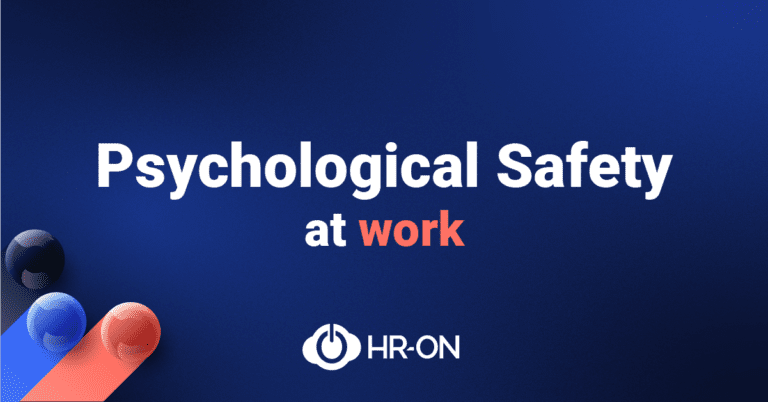How to Create Psychological Safety in the Workplace – Without Shaking the Company’s Foundation
Psychological safety is a buzzword we will come across more often. Psychological safety means employees believe they will not be punished, embarrassed, or humiliated for speaking up, pointing out mistakes and areas of improvement – that it is safe to speak and be honest. At the same time, leaders must engage in an ongoing process to build a psychologically safe workplace.
Are you on the go? Jump straight to the FAQ section.
High job satisfaction, success, and organizational innovations. These are some psychological safety benefits, but how do you know if your employees feel safe? And if not, how should you get started?
In short, psychological safety, also known as psychological security, is experienced when there is mutual trust and respect within a team and where everyone feels comfortable being themselves.
With an increased focus on psychological safety in the workplace, you can, as an employee, help prevent colleagues from experiencing stress. You can take the lead with the management in creating a culture where individuals feel safe expressing any concerns and doubts and pointing out apparent mistakes in their daily work.
You might also like: Stress-Proof Your Workplace: A 5-Step Guide for HR Managers
Ensuring Employee Well-being through Psychological Safety
When a sense of psychological safety is ingrained in a company’s culture, it positively impacts results, learning, and employee well-being. This means that employees are more likely to seek help related to work tasks or personal challenges.
Psychological safety impacts workplace results, learning, and employee well-being.
But such a culture doesn’t develop on its own. So, how do you create the best conditions for a safe environment within your company? We’ll guide you through this in the upcoming sections.
Targeted Steps Towards Greater Psychological Safety in the Workplace
A safe culture does not happen overnight; for example, having an “open-door” policy from the management is not enough. Your role is important in creating the foundation for the desired culture to be established in the company.
There are several ways to approach psychological safety:
- Creating the framework for a safe and secure environment requires a commitment from all employees, including the management, to be open and honest
- Lead by example with constructive feedback and openly discuss your doubts and insecurities by showing trust, listening, and acknowledging the ideas and inputs of other employees
- Create a space for employees to approach you – even with personal challenges – by demonstrating genuine interest in their well-being and accepting all emotions. This increases the individual’s sense of security regarding the leadership style and the organization
- Ask questions and listen
- Celebrate successes and take collective responsibility if a task cannot be solved so it does not burden the individual employee
- Ensure that employees contribute to creating a culture of psychological safety by allowing them to take responsibility and provide input on how to approach it
- Utilize existing rituals in the company to maintain your culture. This fosters employee interaction (e.g., practices related to onboarding new colleagues, team meetings, the framework for company lunches, etc.).
- Check-in with each employee daily using an app where employees rate their day.
HR, Psychological Safety, and a Helping Hand
It’s no secret that the HR department plays a special role and function in the workplace. In addition to serving as the bridge between management and the workforce, HR professionals possess a broad knowledge base and skills to nurture and engage everyone within the organization. Psychological safety is an area of focus that has the potential to rise to the top of the agenda.
But beyond targeted strategies, how can you assess whether you’re moving closer to the goal of psychological safety in the workplace? You can achieve this with HR tools that can act as your helping hand. Your initial steps toward fostering psychological safety could include, for instance, distributing a survey to gain an overview of data and an early insight into how employees truly feel within the workplace.
For example, you can utilize the Engagement Builder in HR-ON Staff, which allows you to send engagements to employees. Your engagement can include information, questions, and predefined response options related to psychological safety. HR systems can thus gather all the necessary data, relieving you from the hassle of collecting information in various spreadsheets and documents, and granting you more time for analysis and development work.
You might also like: Engage Managers and Employees – Use Surveys!
A Company With Trust-Based Self-Management
At HR-ON, value-based management plays a significant role in everyday operations. Essentially, each employee takes responsibility for completing their tasks and meeting deadlines within flexible boundaries.
This approach allows employees to plan their working hours, determine the duration of their vacations, and even take unlimited sick days to care for their children. To ensure that employees consider one another and the overall goals of HR-ON, agreements regarding more extended vacations, for instance, are made in collaboration with the team.
These values are documented in what is known as the Employee Manifesto, and the company has found that it fosters psychological safety when employees, together with the leadership, agree on its contents. If you’re curious about HR-ON’s approach, you can read more about it here.
In conclusion, you can promote greater job satisfaction, increased success, and improved efficiency by fostering psychological safety in the workplace. This can be achieved through trust, open communication, support, and a culture where individuals feel comfortable expressing themselves and addressing concerns. HR-ON offers tools and resources to support the development of such a culture, and by implementing targeted steps, HR professionals can play a crucial role in creating a safe and thriving work environment.
FAQ: Psychological Safety
What is psychological safety, and why is it so important?
Psychological safety is where employees feel safe expressing their thoughts, ideas, and concerns without fear of negative consequences. It is essential because it promotes open communication, learning, and innovation in the workplace.
How do you measure psychological safety?
Psychological safety in the workplace can be measured using various methods, including, surveys, interviews, feedback analysis, behavior observation, absenteeism, and cost rates. The choice of method depends on the company's need and resources. For instance, you can use Engagement Builder in HR-ON Staff for an engagement on psychological safety in the workplace.
How do you create psychological safety?
Some practical steps include establishing clear guidelines for communication and feedback, promoting constructive dialogue, encouraging idea-sharing, and ensuring that employees feel heard and respected.
Can psychological safety improve workplace outcomes?
Psychological safety is associated with improved outcomes, including higher employee satisfaction, increased engagement, lower stress levels, and better performance, as employees are more likely to share knowledge and take initiative.


